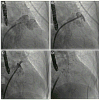Left atrial appendage closure to prevent stroke in patients with atrial fibrillation
- PMID: 25001625
- PMCID: PMC4142351
- DOI: 10.1161/CIRCULATIONAHA.114.009060
Left atrial appendage closure to prevent stroke in patients with atrial fibrillation
Keywords: anticoagulants; atrial appendage; atrial fibrillation; heart disease; prevention and control.
Conflict of interest statement
Figures






Similar articles
-
2015 ACC/HRS/SCAI Left Atrial Appendage Occlusion Device Societal Overview.J Am Coll Cardiol. 2015 Sep 29;66(13):1497-513. doi: 10.1016/j.jacc.2015.06.028. Epub 2015 Jun 29. J Am Coll Cardiol. 2015. PMID: 26133570 Review. No abstract available.
-
Where We Stand on Left Atrial Appendage Closure for Stroke Prevention in Atrial Fibrillation.Tex Heart Inst J. 2016 Aug 1;43(4):320-3. doi: 10.14503/THIJ-16-5811. eCollection 2016 Aug. Tex Heart Inst J. 2016. PMID: 27547142 Free PMC article. No abstract available.
-
Mechanical closure of the left atrial appendage: is it time to be more aggressive?J Thorac Cardiovasc Surg. 2013 Nov;146(5):1018-1027.e2. doi: 10.1016/j.jtcvs.2013.07.011. Epub 2013 Aug 29. J Thorac Cardiovasc Surg. 2013. PMID: 23993272 No abstract available.
-
Left Atrial Appendage Closure in Atrial Fibrillation.J Am Coll Cardiol. 2018 Dec 4;72(22):2806-2807. doi: 10.1016/j.jacc.2018.08.2196. J Am Coll Cardiol. 2018. PMID: 30497568 No abstract available.
-
Left atrial appendage closure: Six reasons why I wouldn't choose a percutaneous closure for my appendage.Int J Cardiol. 2018 Jan 15;251:42-44. doi: 10.1016/j.ijcard.2017.09.015. Int J Cardiol. 2018. PMID: 29197454 Review.
Cited by
-
Left Atrial Appendage Ligation And Exclusion Technology In The Incubator.J Atr Fibrillation. 2015 Aug 31;8(2):1160. doi: 10.4022/jafib.1160. eCollection 2015 Aug-Sep. J Atr Fibrillation. 2015. PMID: 27957184 Free PMC article. Review.
-
Rotational method simplifies 3-dimensional measurement of left atrial appendage dimensions during transesophageal echocardiography.Cardiovasc Ultrasound. 2016 Aug 24;14(1):36. doi: 10.1186/s12947-016-0079-y. Cardiovasc Ultrasound. 2016. PMID: 27553013 Free PMC article.
-
PPP1R12C Promotes Atrial Hypocontractility in Atrial Fibrillation.Circ Res. 2023 Oct 13;133(9):758-771. doi: 10.1161/CIRCRESAHA.123.322516. Epub 2023 Sep 22. Circ Res. 2023. PMID: 37737016 Free PMC article.
-
Feasibility of intracardiac echocardiography imaging from the left superior pulmonary vein for left atrial appendage occlusion.Int J Cardiovasc Imaging. 2018 Oct;34(10):1571-1579. doi: 10.1007/s10554-018-1374-5. Epub 2018 May 22. Int J Cardiovasc Imaging. 2018. PMID: 29790035
-
Epicardial left atrial appendage closure-comparison of surgical techniques in an ex vivo model.J Thorac Dis. 2017 Mar;9(3):757-761. doi: 10.21037/jtd.2017.03.36. J Thorac Dis. 2017. PMID: 28449483 Free PMC article.
References
-
- Go AS, Mozaffarian D, Roger VL, Benjamin EJ, Berry JD, Borden WB, Bravata DM, Dai S, Ford ES, Fox CS, Franco S, Fullerton HJ, Gillespie C, Hailpern SM, Heit JA, Howard VJ, Huffman MD, Kissela BM, Kittner SJ, Lackland DT, Lichtman JH, Lisabeth LD, Magid D, Marcus GM, Marelli A, Matchar DB, McGuire DK, Mohler ER, Moy CS, Mussolino ME, Nichol G, Paynter NP, Schreiner PJ, Sorlie PD, Stein J, Turan TN, Virani SS, Wong ND, Woo D, Turner MB American Heart Association Statistics C, Stroke Statistics S. Heart disease and stroke statistics--2013 update: a report from the American Heart Association. Circulation. 2013;127:e6–e245. - PMC - PubMed
-
- Wolf PA, Abbott RD, Kannel WB. Atrial fibrillation as an independent risk factor for stroke: the Framingham Study. Stroke. 1991;22:983–8. - PubMed
-
- Samsa GP, Matchar DB, Goldstein LB, Bonito AJ, Lux LJ, Witter DM, Bian J. Quality of anticoagulation management among patients with atrial fibrillation: results of a review of medical records from 2 communities. Arch Intern Med. 2000;160:967–73. - PubMed
-
- Gladstone DJ, Bui E, Fang J, Laupacis A, Lindsay MP, Tu JV, Silver FL, Kapral MK. Potentially preventable strokes in high-risk patients with atrial fibrillation who are not adequately anticoagulated. Stroke. 2009;40:235–40. - PubMed
Publication types
MeSH terms
Grants and funding
LinkOut - more resources
Full Text Sources
Other Literature Sources
Medical

